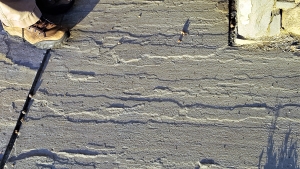More about bluestone
The Catskill Geologists; Mar. 8, 2019
Robert and Johanna Titus
Recognition, they say, is the first step towards learning–and liking something. Can you walk down the beach and put names on all the shells you see? Well, then your interest in mollusks will surely blossom into a love. It’s the same for trees, flowers and birds as you walk through the woods. And it’s very much the same with our science of geology. As you learn to identify fossils, minerals and rock types, you just naturally develop an affection for them. Soon you join a rock and mineral club and then it all gets better.

We play upon this in our columns; the more you learn to recognize geological features, the more fascination you will likely develop for them. Our job is only to introduce you to these features; you do the rest. In recent columns we have been walking down bluestone sidewalks and learning to recognize features upon them. They are widely seen throughout the Catskills and the two of us have become rather fond of them. We have walked down so many of them and learned to recognize the secrets that they can reveal to the trained geologist’s eye. Today, let’s introduce you to yet another.
Take a look at our photo; it shows a bluestone sidewalk slab displaying features called current lineations. They are also commonly known as parting lineations. We have also heard them called flow lineations. Whatever the name, these are very low ridges of sandstone, lying on the surfaces of bluestone slabs. They are composed of very thin horizons of sand, with the ridges often rising just a few grains above adjacent lower horizons. Once you train your eyes to see these, you will find them to be common and easily spotted. But—what on earth are they?
Notice how strikingly parallel they are. They all pass left to right in our photo. That is a big clue. These are the products of river currents that long ago passed across the floor of, we guess, an ancient stream bottom. Geologists have calculated that these were strong currents, traveling at two to four feet per second. Some geologists even claim they can tell which way the current had been going. In our photo that might have been left-to-right or right-to-left. But we have never been able to convince ourselves that we can do that. Ours, here in the Catskills, formed on the bottoms of the Devonian age streams that flowed across the ancient Catskill Delta. That delta was a heap of sediment that formed at the bottom and west of the Acadian Mountains that once towered above today’s northern New England. The Catskill Delta hardened into what are called the Catskill Mountains. And, with that petrifaction witnessed many stream deposits turned into rock.
At the time of deposition these sedimentary structures would have been nearly invisible. It was only when the bluestone slabs were split by quarrymen that they sprang to life, becoming something the eye could take notice of. The process of splitting brought the lineations to light—quite literally.
So, now you have learned something you likely didn’t know before. Now, your walks down our bluestone sidewalks will take you into the Devonian and onto the floors of those ancient streams. Perhaps you should bring your children along—or, like us, bring your grandchildren.
Contact the authors at randjtitus@prodigy.net. Join their facebook page “The Catskill Geologist.”





